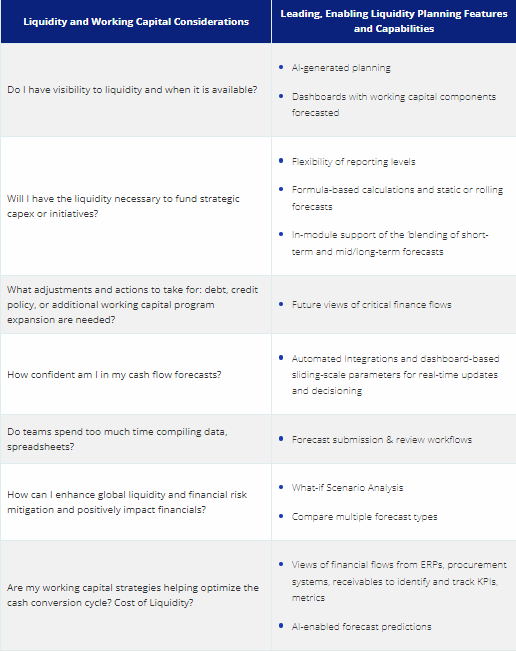3 Ways Liquidity Planning Technology Improves Cash Flow Forecasting Results
03-01-2023 | treasuryXL | Kyriba | LinkedIn |
The treasurer and CFO are today more closely linked to strategic financial objectives for the CEO, ensuring finance teams provide informed guidance on navigating risks and opportunities. This year, a revolutionary practice area and innovative technology is transforming the value of short and long-term cash flow forecasting with more certainty and analytics, empowering finance with a strategic liquidity planning toolset.
By Brian Blihovde
Senior Direct, Product Marketing

The treasurer and CFO are today more closely linked to strategic financial objectives for the CEO, ensuring finance teams provide informed guidance on navigating risks and opportunities. This year, a revolutionary practice area and innovative technology is transforming the value of short and long-term cash flow forecasting with more certainty and analytics, empowering finance with a strategic liquidity planning toolset.
Modern technology solutions are driving value across cash flow forecasting and strategic planning through inclusion of more information from different sources, using artificial intelligence (AI), machine learning and flexible scenario analysis. These user interfaces, reporting and analytics provide finance with better identification of free cash flow targets, improve EBITDA, and deliver views and analysis of total working capital levels.
Creating Engagement and Clarity in Liquidity Decisions
New technology solutions for liquidity management planning create forecasts and analyses on actuals and planned cash flows to include liquidity instruments from debt to working capital programs. When the combination of cash, planned or committed financial flows (AP, AR, treasury) are used as an integrative planning tool with analytics, decision-making for the CFO is more accurate and based on today’s and tomorrow’s reality. Forecasted transactions originating from purchase requisitions, orders and finally invoices are a much better source of forecasted flows than spreadsheet estimates.
Liquidity planning tools and features created as part of an advanced solution gives finance the ability to see exact components of working capital and cash flow forecasts further out to deliver clarity on whether debt or other sources of liquidity will be too expensive. Identification of the mix of liquidity needed and the availability of planned sources or uses further helps the treasurer plan the intersection of borrowing levels, cash flows and confidence parameters for various scenarios and comparisons. The ability to quickly adjust parameters within a planned liquidity model with established, accurate cash management baselines, makes the job easier and faster for not only treasury and FP&A, but gives the CFO quick strike decisioning on the planned mix of cash and debt to fund operations or strategic decisions.
Achieving Optimal Levels of Liquidity
Global economic volatility continues to impact multinationals across a variety of indices and continued strategies by central banks to slow inflation with interest rate increases translates into significantly increased costs of borrowing. For finance organizations that provide liquidity as a net short-term borrower, it is extremely important treasurers can assess the mix of debt and the most advantageous debt instruments, or working capital programs, available. Treasury teams can directly impact greater overall financial performance by optimizing the cost of liquidity and keeping the right levels of available debt and free cash for investments. Modern liquidity planning solutions create better long-range views of available debt vehicles in cadence with cash and other programs to help prescribe the correct mix of long and short-term borrowing. Identifying where short-term debt has carrying costs over other sources of liquidity while also reducing the number of overall debt instruments (facilities or other lines) reduces costs that affect net earnings. Liquidity tools that incorporate the complete set of debt vehicles coupled with cash and forecasted flows create more ability to lessen reliance on borrowing, reducing and optimizing debt levels – all significant contributors to a stronger EBITDA.
Expanding C-Suite Confidence with Future Analytics
In a recent cash forecasting webinar, 90% of attendees stated that they “lose confidence in their forecasts within three months.” Regardless of a static or rolling forecast scenario, lack of confidence in your firm’s future cash and liquidity levels hinders the ability to fund longer-term, accurate strategic decisions without having more of a backup in the form of higher credit limits available to shore up potential liquidity shortfalls.
The new cash forecasting features and capabilities available in new liquidity planning tools are creating better capabilities to manage longer-term liquidity questions:

As the economy continues to spiral, uncertainty will bring down the values of organizations who are incapable of managing the rate at which volatility impacts EBITDA – a consequence of legacy thinking and systems. CFOs and treasurers who are taking a new tact in leveraging liquidity across the enterprise, are finding success in minimizing impacts to their income statement and have an unobstructed vision for how they can unlock near and long-term growth.










